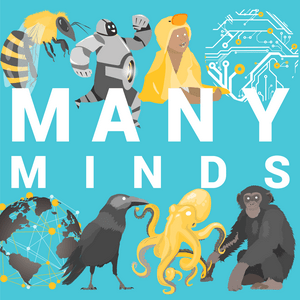One afternoon you decide to snub your responsibilities and go for a hike. You spend a few hours in the woods or the mountains. You study the bark of trees, you bathe in birdsong, you let your eyes roam along a distant ridgeline. And you come back feeling better, restored somehow—like you have more energy, more patience, more bandwidth. We've all, I'm guessing, had experiences like this. But what's behind these effects? Why would nature restore us? What's the evidence that it really does? And what is even being restored, actually? My guest today is Dr. Marc Berman. Marc is an Associate Professor in the Department of Psychology at the University of Chicago where he directs the Environmental Neuroscience Lab. Marc is also the author of a new book, Nature and the Mind: The Science of How Nature Improves Cognitive, Physical, and Social Well-Being. Here, Marc and I talk about Attention Restoration Theory—the idea that nature experiences restore our limited capacity for directed attention. We discuss the broader field of "environmental neuroscience," which Marc helped kickstart and continues to lead. We range across studies from Marc's lab that show nature's beneficial effects—on attention, on mood, and on health. We talk about what the active ingredients in nature seem to be. And we discuss the field's prospects for understanding how nature impacts not just the mind, but the brain itself. Along the way, Marc and I touch on: soft versus harsh fascination; the elusive concept of "mental energy"; trees, wood, fire, and rain; the architect and theorist Christopher Alexander; the value of fake plants; fractalness in space and time; curvature and spirituality; and how nature tends to steer our thoughts in certain directions. Needless to say, we're stoked to be kicking off a new season of Many Minds. If you're new to the show, welcome! If you're already a fan, perhaps you'd consider leaving us a rating or a review on your platform of choice. It really does help us reach new listeners. Alright friends, on to my conversation w/ Dr. Marc Berman. Enjoy! Notes and links 7:00 – For more on Attention Restoration Theory and the distinctions it makes between directed attention and involuntary attention, see this paper by Dr. Stephen Kaplan. For more on the construct of "directed attention" in general, see this paper by Dr. Kaplan and Dr. Berman. 12:00 – For an overview of the aims and scope of "environmental neuroscience," see this paper by Dr. Berman and colleagues. 17:00 – The 1989 book by Dr. Stephen Kaplan and Dr. Rachel Kaplan, The Experience of Nature 21:30 – For the "walk in the park" study that kickstarted Dr. Berman's research on environmental neuroscience, see here. 25:30 – For some of Dr. Berman and colleagues' work on nature sounds, see here and here. 27:00 – For a study on the possible benefits of nature for children with ADHD, see here. 30:00 – For more on the Garden of the Phoenix (aka the Osaka Garden) in Chicago, see here. For a news article about the benefits of "tiny forests," see here. 34:00 – See here for the follow-up to the "walk in the park" study with people experiencing depression. 38:00 – For the study on the relationship between tree cover and cardiometabolic health in Toronto, see here. 44:00 – For the classic study by Dr. Roger Ulrich on how the view from one's hospital room may impact recovery, see here. 47:00 – For more on the link between crime and nature in apartment complexes in Chicago, see here. 49:00 – A preprint by Dr. Berman and colleagues on the "compressibility" and memorability of natural images is here. 55:00 – For some of Dr. Berman's earliest work on the "low-level" visual features of natural scenes, see here. 57:00 – For the work, led by Kathryn Schertz, on how natural (or non-natural) images with curved edges direct our thoughts, see here. 1:01:00 – The firelight talk paper is here. 1:02:30 – For the study by Dr. Schertz, Dr. Berman, and colleagues comparing thoughts in the conservatory and at the mall, see here. 1:05:00 – For the study on a historical increase in the use of the generic term "tree" in English, see here. 1:06:00 – Christopher Alexander, the architect and theorist, is perhaps best known for his (co-authored) book, A Pattern Language. For the study by Alex Coburn, Dr. Berman, and colleagues, see here. 1:09:30 – To get a visual flavor of La Sagrada Familia, see here. 1:18:00 – The study on whether people can reliably predict how much they will enjoy a walk in nature. 1:20:00 – For some of Dr. Berman and colleagues' initial work on temporal "fractalness" in the brain, see here. Recommendations Greg Bratman et al., 'Nature and human well-being: The olfactory pathway' Kim Doell et al., 'Leveraging neuroscience for climate change research' Lucia Mason et al., 'Short-term exposure to nature and benefits for students' cognitive performance: A review' Many Minds is a project of the Diverse Intelligences Summer Institute, which is made possible by a generous grant from the John Templeton Foundation to Indiana University. The show is hosted and produced by Kensy Cooperrider, with help from Assistant Producer Urte Laukaityte and with creative support from DISI Directors Erica Cartmill and Jacob Foster. Our artwork is by Ben Oldroyd. Subscribe to Many Minds on Apple, Stitcher, Spotify, Pocket Casts, Google Play, or wherever you listen to podcasts. You can also now subscribe to the Many Minds newsletter here! We welcome your comments, questions, and suggestions. Feel free to email us at:
[email protected]. For updates about the show, visit our website or follow us on Bluesky (@manymindspod.bsky.social).



